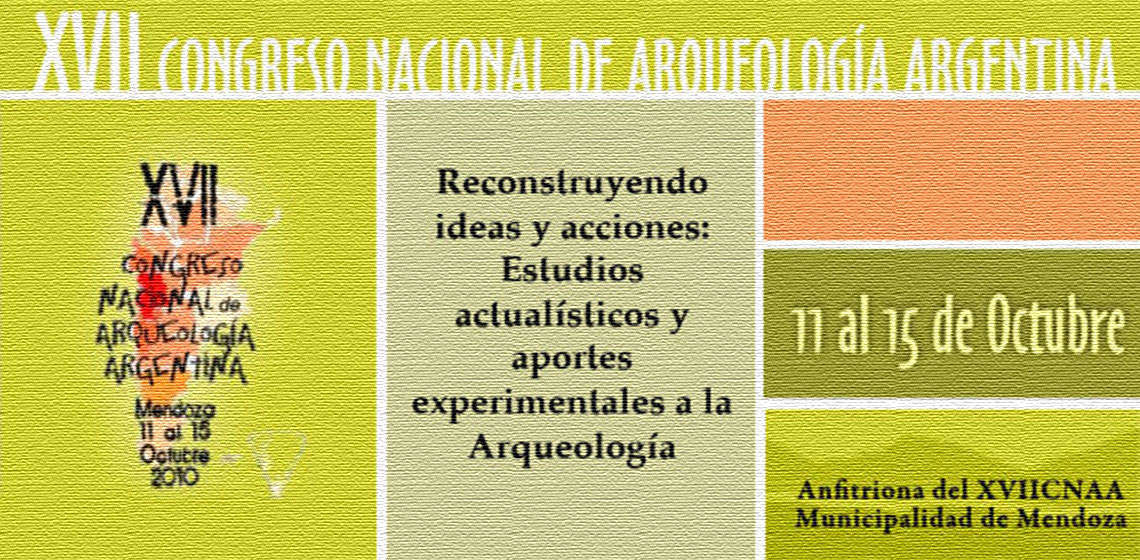
17th Argentina’s National Archaeological Congress
Symposium 25: Reconstructing ideas and actions: Actualistic Studies and Experimental Approaches to Archaeology
For many years, actualistic studies have been used largely as a bridging link between archaeological data describing how people use objects with the human behaviours or natural processes associated with this use. This development of Middle Range Theory has many fields of application.
Actualistic studies have been applied to understand the archaeological record in Argentina since mid 1970’s. These have focused on taphonomy, archaeozoology, lithics, ceramics and different topics.
Symposium 25 was proposed by archaeologists Leonardo Salvador Paulides and Mariana Sacchi, both from Universidad de Buenos Aires on the context of the 17th Argentina’s National Archaeological Congress which was held during 11-15 October, 2010 in Mendoza City at the Facultad de Filosofía y Letras (Universidad Nacional de Cuyo). The symposium went by the name Reconstruyendo ideas y acciones: Estudios actualísticos y aportes experimentales a la Arqueología. The initiative was to put together different approaches related to new developments in diverse geographic areas and research topics in a single meeting. Luis Alberto Borrero, head researcher of the National Committee of Scientific and Technical Research (CONICET) and professor at the Universidad de Buenos Aires, acted as moderator. The papers presented totalled eleven and dealt mostly with lithics, archaeological clay provenience, experimental pottery, rock art, entomology applied to taphonomical problems, thermal alteration of Caviomorpha and Dasypodidae and relationship of isotopic values between diet breath and human nutritional status.
The first section of the event started with lithic studies. Virginia Lynch and Dario Hermo presented results on hafted scrapers experiments from the Piedra Museo site (Santa Cruz Province). Susana Pérez and Julio Ávalos introduced use-wear edge experiments on farming tools from Jujuy’s Puna Oriental region. Nora Flegenheimer, Patricia Escola and Cristina Bayón, gave a historical briefing on 15-year knap-in course called “Tecnología Lítica en Acción” supported by the Universidad Nacional del Sur, in which knapping skills for understanding the lithic record are taught.
Second, ceramics were represented by Lucas Domingorena, whose PhD dealt with clay composition and provenience in Valles Calchaquíes region. Furthermore, Rosa Moyano, Liliana Sammarco and María Clara Marquet worked on experimental manufacturing processes of Agrelo style pottery, northern Mendoza.
Rock art was represented by Rocío Blanco, who introduced interesting approaches towards the understanding of different rock art techniques related to Piedra Museo and Cerro del Doce sites, central Santa Cruz.
Third, Silvana Urquiza, Fernando Aballay, Gustavo E. Flores y Néstor Centeno presented work on the importance of entomology for the understanding of taphonomic processes on desert areas from Puna in Antofagasta de la Sierra, Catamarca province. Matías Medina and Pablo Teta experimented on thermal alteration and consumption of Caviomorpha rodents from Quebrada del Real in Pampa de Achala, Córdoba; whereas Romina Frontini and Rodrigo Vecchi, experiment on thermal alterations in small armadillos from the Pampas.
The last section of the symposium was related with isotopic values in humans and animals in southern Mendoza (Ugan et al.) and Andrew Ugan, Carina Llano and María Balanza’s nutritional composition, energetic returns and metabolic pathways of wild plants based on experimental evidence for southern Mendoza. The final remarks on the event were given by Luis Borrero, who humorously suggested that the Symposium should have been called “This is the way we are interpreting the archaeological record”. The originality of each work was outlined as well as the different and varied approaches to multiple lines of evidence in Argentina’s current archaeological work.